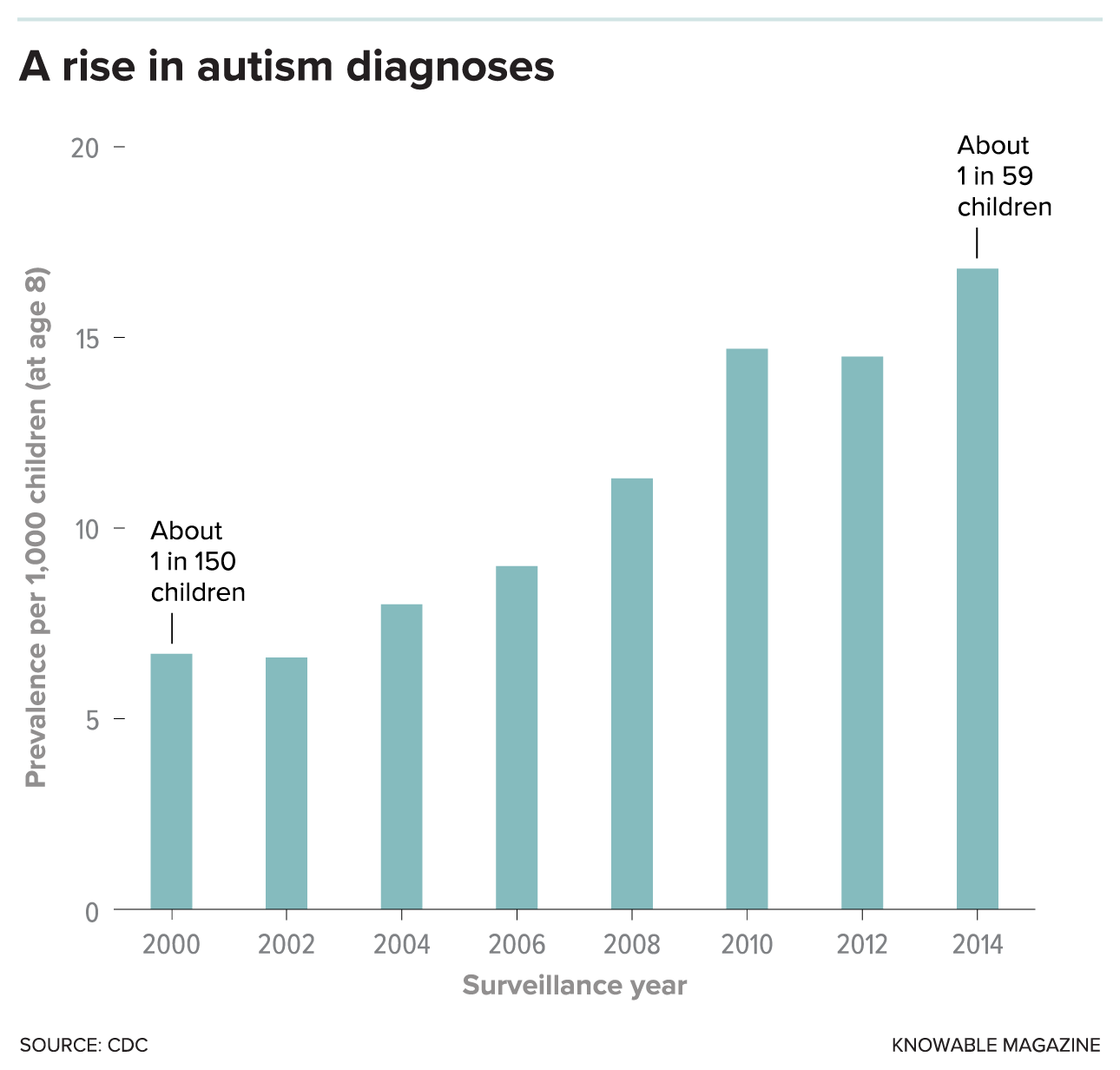Research indicates that autistic brains exhibit more diversity than non-autistic brains. If autism research is truly going to address the needs of such a varied population, then it needs to branch out similarly, get real about what autistic people need, and humanize its priorities.
Tag: Emily Willingham
Emily Willingham Knowable Magazine As alarm grew over autism prevalence at the turn of this century, there was much public talk of a growing “epidemic.” That language has since softened, and it is now clear that many autistic people were there all along, their condition unrecognized until relatively recently. But what is the cause? The emerging narrative today is that there is no single cause—rather, multiple factors, roughly sorted into the categories of genetics and environment, work together in complex ways. Because of this complexity and the hundreds of gene variants that have been implicated, developing human brains may follow many possible paths to arrive at a place on the autism spectrum. And this may help explain something true about autism: It varies greatly from one person to the next. As clinicians view it, autism involves communication deficits and formulaic, repetitive behaviors that present obstacles to establishing conventional relationships. The…
Shannon Des Roches Rosa www.squidalicious.com Photo © Jeffrey Beall | Flickr / Creative Commons [image: Photo of metal letters spelling “Science” affixed to a brick wall.] At a recent workshop on How to Find Autism Information That Will Help You, I noted that a key factor for evaluating an autism resource is: Who does the approach primarily benefit? Autistic people themselves, or people affiliated with autistic people, such as families or teachers? It’s important to identify this aim, because approaches that support autistic people in living lives of maximized happiness and potential can be very different from the parent-centered approaches—which too often portray autistic people as problems to be managed and controlled. We at Thinking Person’s Guide to Autism support the helping approach, and routinely criticize the problem/control approach—an ongoing effort as the latter remains pervasive both in popular culture, and in research. The problem/control approach is also a theme…
Shannon Des Roches Rosa www.thinkingautismguide.com We’ve said it before, we’ll say it again: There Is No Autism Epidemic. Not even after US estimates for autism prevalence recently rose to 1 in 45. How do we know there’s no autism epidemic? Two reasons: A comprehensive survey of autism prevalence in Korea estimated a rate of 1 in 39, as reported in 2011. There’s no reason US rates should be much different, so the new numbers are likely portraying reality more accurately, rather than indicating reality is changing. Researchers have been saying for years that autism’s prevalence has mostly risen in response to changes in diagnostic criteria, rather than due to environmental triggers or other causation ideas. The role of changing diagnostic criteria in rising autism rates is particularly relevant right now, given that theme’s prominence in Steve Silberman’s award-winning, current bestseller NeuroTribes. Silberman devotes a sizable section of the book to…
There are so many absurd theories about autism causation. Who really would have the wherewithal to follow the growing list of “factors” linked to autism? (Emily Willingham would.)
Shannon Des Roches Rosa www.thinkingautismguide.com Yesterday the U.S. Centers for Disease Control and Prevention (CDC) held a media briefing to announce and discuss readjusted estimates for autism prevalence: 1 in 68 children. But what does that estimate actually mean? Well, that takes some critical analysis, digging, and sifting, which we’ll walk you through, starting with the CDC’s Dr. Colleen Boyle’s opening statement: “CDC estimates that one in 68 children has been identified with autism. This estimate is based on information collected from health and special education records of children who are eight years old and living in 11 communities in Alabama, Arizona, Arkansas, Colorado, Georgia, Maryland, Missouri, New Jersey, north Carolina, Utah, and Wisconsin in 2010. These data are from CDC-sponsored autism and developmental disabilities monitoring network. The new estimate exceeds previous overall estimates, roughly it’s 30 percent higher than our last estimate of one in 88 children. To better…
One week ago, TPGA editors Shannon Des Roches Rosa, Jennifer Byde Myers, Emily Willingham, and Carol Greenburg spoke as a group at the University of San Francisco’s Developmental Disabilities Conference. It was an honor and a privilege to talk with a group of (mostly) professionals about how we use the power of social media to support our principles and TPGA’s mission, including autism acceptance and civil rights for people with disabilities, evidence-based approaches to autism supports and research, and debunking autism myths and misinformation. TPGA editrixes, post-UCSF session Shannon, who opened the discussion, is TPGA’s senior editor, and the parent of an autistic child. Thinking Person’s Guide to Autism (TPGA) is a book, a blog, and a community. We aim to support autistic people and their families, counter negative media messages and autism stigma, and provide positive autism attitude role models. We created TPGA in 2010 to be the resource…
We’re excited to let you know that Thinking Person’s Guide to Autism is coming to Kepler’s Bookstore in Menlo Park on Tuesday June 25th at 7:30 pm. Editors Shannon Des Roches Rosa, Jennifer Byde Myers, and Emily Willingham, along with contributors Laura Shumaker and Susan Walton will be on the panel. We’ll do a bit of reading, and have plenty of time for questions and answers. We’re hoping there will be other Bay Area contributors at the event as well. If there is anything you’d like us to share at the reading please leave a comment below and we will do our best to cover the subject. Thank you for your continued support of Thinking Person’s Guide to Autism. -The Editors Share this event on Facebook If you are interested in having someone from Thinking Person’s Guide to Autism speak at your event or local bookstore please contact us at…
Emily Willingham emilywillinghamphd.com You’ve heard of autism, right? Thanks to ubiquitous blue puzzle pieces, TV shows and movies, and daily headlines in English-language news media, a lot of people in the United States have some awareness about autism, even if it’s a caricatured version presented to gain donations, viewers, or readers. In fact, in the US, many autistic people and their allies have sought to move on from awareness and talk more about acceptance. In non-USian parts of the world, though, autism doesn’t necessarily get this level of attention, much less acceptance, despite the fact that autistic people are everywhere. One of the largest epidemiological studies of autism identified it in 2.64%% of South Korean schoolchildren, and anecdotal assertions to the contrary, autism does exist in countries like Cambodia. Autistic people also live in Yemen, where a lack of awareness can seriously affect outcomes. As Yemeni mother Fam Um Ahmed said in…
Jennifer Byde Myers jennyalice.com We want April — Autism Acceptance Month — to matter, to help further acceptance and understanding of autistic experiences, happiness, and rights for autistic people of all ages and abilities. We will be publishing Autism Acceptance posts and pictures all month long. -TPGA Editors When we first started Thinking Person’s Guide to Autism (TPGA), our goal was to put, all in one place, the best information from autistics, parents of autistic children, and the professionals who serve our communities. We always felt it was key to deliver this information with frankness and with honesty, especially regarding autistic struggles, and challenges with aspects of education and parenting. We did not want to seek pity, or place blame. Instead, we sought to highlight neurodiversity as part of the fabric of humanity, part of what it means to be human. We wanted to present a variety of perspectives about…






